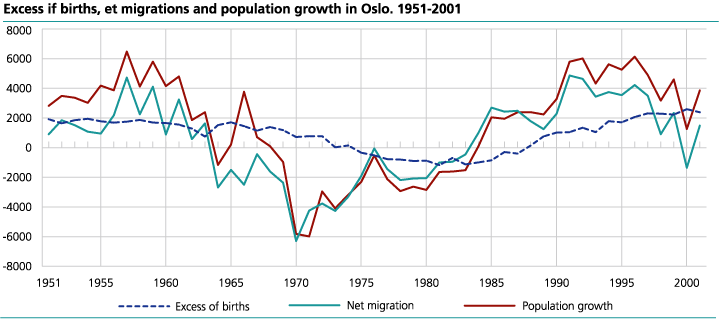Content
Published:
This is an archived release.
More or fewer in your municipality?
Historic Survey of population changes in each municipality from 1951 are now updated with population changes during the year 2001, and resident population per 1 January 2002.
It has now become easier to study population changes in the individual municipalities by using the historical statistical series with annual figures on population, population growth, excess of births over deaths, net migration, live births, deaths, in-migration and out-migration.
Various reasons for growth
Long time series with annual figures for each municipality provide a retrospective look at periods with changing conditions for growth and development, making development trends more distinct. Population trends are presented and population growth and decline can be studied, including breakdowns by excess of births over deaths and migration balance. The time series can answer whether a higher excess of births over deaths is due to more births or fewer deaths, and whether less favourable migration balances are because of less in-migration or more out-migration.
What the time series show
The historical material shows how for several decades since 1950 a very large number of municipalities in the north and west have been loosing population to the rest of the country. This net loss was at times just as large or larger than in the last couple of decades, but many municipalities nevertheless had considerable population growth because of high birth figures. Not until the 1970s, when births fell dramatically in all parts of the country, did the excess of births over deaths become too small to compensate for out-migration.
The number series for the City of Oslo, whose boundaries have remained virtually unchanged since 1948, show that population growth has fluctuated considerably in the last 50 years. The population has nevertheless not increased more than 18 per cent. The direction and strength of migration flows have changed. Never have more children (in absolute numbers) been born as in recent years. The capital city is therefore now experiencing a solid excess of births over deaths compared with the early 1980s, when there was a considerable deficit.
Changing borders a problem
The figures presented are for the municipal boundaries in effect at any one time. The numerous and extensive redrawing of municipal boundaries during the period, particularly in the 1960s, make comparisons over time extremely difficult in a number of municipalities. Because no figures exist for births, deaths and migration for areas smaller than whole municipalities, no attempt has been made in this publication to compute time series for current municipal units previously affected by boundary changes. Breaks in the number series are marked in the tables and information about boundary changes and population in transferred areas are given.
Useful Excel tables
Many of the 434 currently existing municipalities are nonetheless composed for the most part of several previous municipalities. Trondheim, Harstad, Fredrikstad and Gjøvik are examples. As the available material in the form of Excel tables also includes 310 separate tables for no longer existing municipalities, a number of exact or approximate figures for current municipal units can be made. Most county figures are comparable, as the counties have been affected very little by boundary changes during the period.
The statistics is published with Population.
Contact
-
Statistics Norway's Information Centre
E-mail: informasjon@ssb.no
tel.: (+47) 21 09 46 42

